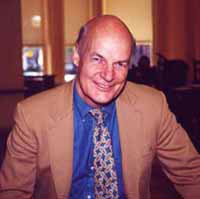Technology and Social Inequities in Education
Educators, experts and innovators converged on Columbia's main campus in early May for the second annual Educational Technology Summit to learn and share ideas about the still nascent field of computing and education. The summit, titled "Creating the Digital Education Community," focused on the relationship between educational technology and social inequities in education.
Speeches were given by former Senator and current New School President Robert Kerrey; Director of Education Technology from the U.S. Department of Education, John Bailey; Vice President of Classroom Connect, Rem Jackson; as well as TC's Robert McClintock and Peter Cookson. They touched on the Summit's theme of "considering both the larger strategic directions of educational technology along with a practical examination of currently available classroom technologies."
"We truly are standing on the threshold of a transformation in the education," said TC President Arthur Levine in his opening remarks. "Alas, these children too often get lost in the swirl of technological hype and educational bureaucracy."
Fully realizing the potential of multimedia, Rem Jackson used both PowerPoint and a piano to drive home the message that the technology is one piece but professional development is just as important. He also noted that one of the fundamental goals of his company was to provide tools and resources for teachers in the classroom. "Teachers need the instructional materials more than simply connecting computers to the internet to effectively use technology in the classroom," said Jackson.
Most keynote speakers agreed that much effort has been expended in getting technology into the classroom and now is the time to harness the potential of the technology to help people learn.
"Our culture has set in motion a very powerful trajectory with digital technology," said Robert McClintock, Professor at TC and co-director of the Institute for Learning Technologies.
"Educational technology for us as educators presents us with some real significant empowerments that we can use, but we also have to recognize that they are empowerments that we may fail to use," said McClintock. Technology, if used correctly, can "awaken your ideas, allow [students] to recognize their own intelligence."
McClintock brought to his speech a global perspective as well, as he warned that we also need to be wary about the inequities in the dissemination of technology, as it can be used to accumulate wealth and power at the expense of others and the current limits of our current political tools.
Peter Cookson, president of Teachers College Innovations, an office for nationwide outreach, spoke on the second day, noting that "In the next decade the United States is going to need 2,000,000 new teachers." And that will require recruitment, training and retention.
"We need to be ready to take on the challenges of the 21st century, but our schools are not prepared to produce the students that are ready to teach in the 21st century," said Cookson. "A girl born today has a very good chance of living beyond a hundred years old, what kind of century is she going to live through? What does she need to be prepared to deal with changes? What kind of students do we want to become the adults? We want them to be ethically mature, we want them to be creative, we want them to have judgment, and we want them to be free from the rigid ideologies that blind us from seeing the future."
This year's conference was arranged by Joshua Halberstam, President of VayaVentures and adjunct professor at Teachers College.
Published Thursday, Jul. 11, 2002
